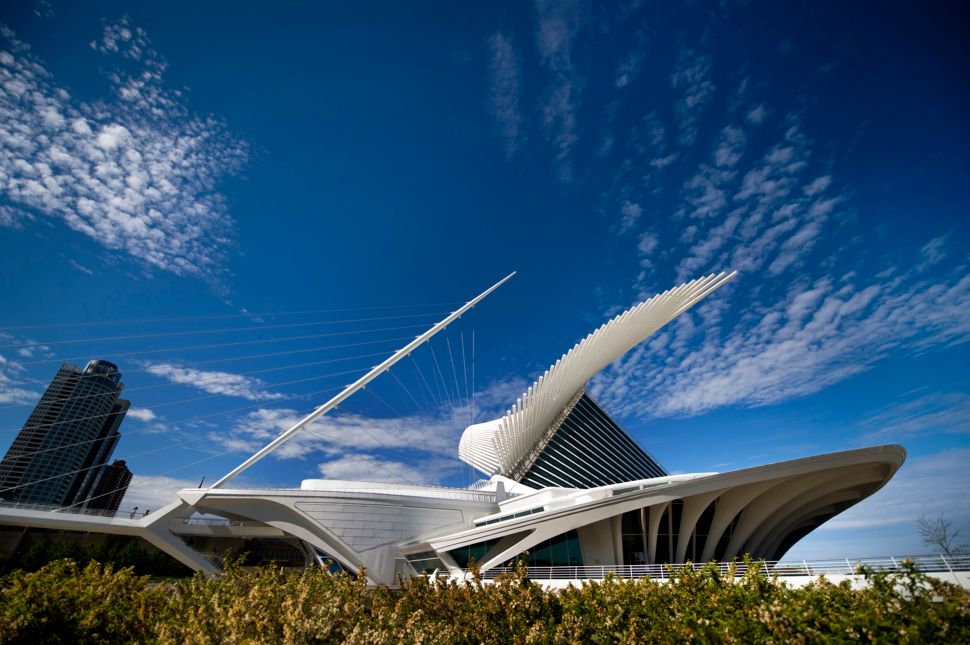Santiago Calatrava unveiled his first American commission—the Milwaukee Art Museum’s Quadracci Pavilion—in 2001. His original concept for the 142,050-square-foot addition had visitor-service desks flanking both sides of the museum’s interior West entrance, but at the time of the project’s completion, the institution’s then-leadership made the decision to move the desks, which Calatrava also designed, into Windover Hall.
With soaring ceilings and curved walls of windows overlooking Lake Michigan, as well as a 90-foot-high glass ceiling, the institution’s immersive addition is an artwork as noteworthy as any piece in the museum’s permanent collection, which includes works by Claude Monet, Winslow Homer, Georgia O’Keefe, Andy Warhol and Camille Pissarro. The Milwaukee Art Museum (colloquially known as MAM) also has one of the world’s largest collections of folk and self-taught art, along with Haitian art.
Unfortunately the change, which was intended to center Calatrava’s design, created a cluttered sightline—particularly on busy days when lengthy queues formed at the visitor desks. Stepping foot in the institution, rather than inspiring wonder, often inspired frustration.
Twenty-two years later, Scott Schwebel, the museum’s chief experience officer, had a bright idea: why not move the desks back to where Calatrava intended them to be, tucked back in the galleria spaces? That way, he tells Observer, “when you walked into this grand cathedral of a space, you had an unobstructed experience and were instantly hit with the awe and the majesty.”
Schwebel’s role is a unique one. He’s responsible for making the museum more engaging and inviting to new visitors, particularly those unfamiliar with museum culture—a demographic that once included Schwebel himself.
“I didn’t come out of the museum world; I’m not an academic. Returning the desks was part of a bigger strategy I’m bringing to the museum about hospitality,” he explains. “And one of the classic pillars of hospitality is ‘we see you first, we greet you, we make eye contact, we welcome you, we disarm you, we let you know we’re here.’”
According to Schwebel, the Milwaukee Art Museum attracts a lot of first-time visitors. “There’s anxiety, right? They don’t know how to act, where to go, what to do.” His goal is to create a museum experience in which that visitor’s first engagement is with a human and they feel welcome.
Putting this philosophy into practice, MAM staff now greet guests upon entry—long before they’re at the service desk. The effect is both pleasant and practical. Greeters direct visitors to the desks or help them buy tickets online and point them toward the museum’s café, restrooms or gift shop, which means shorter queues at the desks.
“I want people to encounter a person first,” says Schwebel. “Someone is always there, and they’re saying hello. It breaks down some of the barriers and creates accessible, enjoyable first impressions.”
Although Schwebel is the Milwaukee Art Museum’s first chief experience officer, having come on in October 2023, he’s far from the first in the museum world. And while this role is a relatively new one in arts institutions, it’s older than most people realize.
“It’s a role that probably has a twenty-year history in hospitality and among brands that have physical expressions of what they do,” he says. “It takes the CMO role and portions of the COO role and merges them together. It’s all part of the drive for visitation and engagement.”
Beyond that direct human engagement, Schwebel has also reactivated the full suite of twenty-six speakers installed by Calatrava in Windover Hall. Sound can be another source of comfort, he explains. “One of the most uncomfortable experiences is when you walk into an environment you don’t know and it’s silent. I’ve added music to ease you in. Someone who has a child doesn’t feel like, ‘Oh my god, do I need to hush?’”
Not every change Schwebel has made at MAM was inspired by Calatrava’s original design, though each has been just as thoughtfully executed with the visitor experience in mind. For instance, he relocated the museum’s gift shop from a windowless spot in a hallway that was a long trek from the museum’s entrance to a more prominent spot in Windover Hall that was once used as a meeting room.
SEE ALSO: What’s Ahead for the Art Auction Market in 2025
The new gift shop has double the square footage spread over two stories and a wall of windows to give visitors a taste of what they’ll find within. Calatrava’s “boomerang” display case was relocated to the second floor and now holds artist-made jewelry—the shop’s highest-return category item. The first floor displays mainly branded merchandise like T-shirts and postcards.
“Twenty-five years ago, when the discussion about the addition was just starting, I’m not really sure there was the same level of understanding about the importance of retail in cultural institutions,” says Schwebel. “My guess is that if Calatrava had this same assignment today, the store would be exactly where it is now.”
For all of Schwebel’s professional experience in the realm of engagement—which includes stints in the food and beverage industry, retail and hospitality, music and entertainment—he’s still happy to get hands-on. He frequently works shifts as a greeter so as to stay connected with the MAM audience. “It’s a wonderful way to understand who’s coming to see you,” he says.

